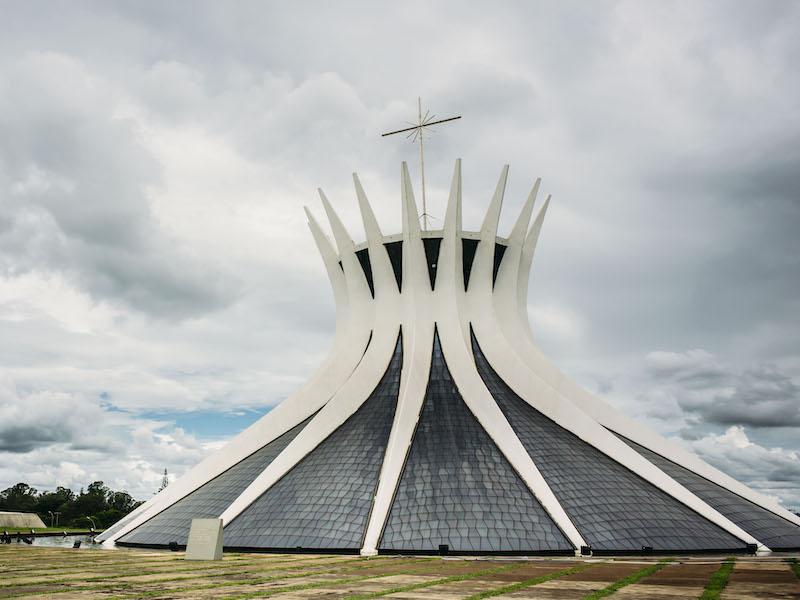Oscar Niemeyer – Brazil's Greatest Architect

Oscar Ribeiro de Almeida Niemeyer Soares Filho, born December 15, 1907 in Rio de Janeiro, was a famous Brazilian architect and is considered a pioneer of modern Brazilian architecture. Niemeyer designed numerous public buildings for the Brazilian capital Brasília, which was declared a World Heritage Site in 1987. After his death on December 5, 2012, his architectural drawings and building plans were declared a World Documentary Heritage by UNESCO in 2013. The heritage thus created is accessible to anyone interested in cities and architecture, and should definitely be seen on a Brazil vacation!
Rise
Oscar Niemeyer, after graduating from school in 1928, began studying at the "Escola Nacional de Belas Artes", the "National School of Art" in Rio de Janeiro, following the innovative teachings of its director, Lúcio Costa. He complemented his education by studying colonial architecture and South American Baroque, but above all the writings of Le Corbusier, which were a true source of inspiration for him.
In 1934 he graduated as an engineer and architect and opened his first company in 1936. In 1937 he designed the "Obra do Berço" in Rio de Janeiro, his first building project. Niemeyer became so familiar with the methods of the Modernist master that his plans for the ESM project were selected by Costa for construction between 1936 and 1943.
In the process, he collaborated with Carlos Leão, Affonso Eduardo Reidy, Jorge M. Moreira, and Ernani Vasconcelos, among others, and met the architect Le Corbusier, who came to Rio de Janeiro at the invitation of Lúcio Costa and Gustavo Capanema, Minister of Education and Health of the Getúlio Vargas government, to act as consultant for the ESM and Cidade Universitária projects. This gave the architect, who later became famous, his first notoriety and at the same time allowed him to learn from many different architects.
Experience
After another collaboration with Le Corbusier on the construction of a kindergarten in Rio in 1937, Niemeyer designed the house of the Brazilian poet Oswald de Andrade in 1938. He took charge of the architectural team the following year with Lúcio Costa and Le Corbusier as consultants. He made his debut on the international stage with the Brazilian pavilion at the 1938 New York World's Fair, which he designed with Costa and Paul Lester Wiener.
Among his first independent works was the Grand Hotel in Ouro Preto in 1940, which cleverly combined modern and traditional elements.
He was commissioned by the government to organize an exhibition of Brazilian industry in Buenos Aires in 1940.
But it was above all with the buildings in Pampulha, a suburb of Belo Horizonte, that Niemeyer developed his own style, consisting of the later typical beautiful, sensually curved surfaces designed to evoke various emotions and feelings and showing a strong Baroque influence. As a result, Brazil's most famous architect also gained international fame.
Brasília – The highlight of Brazil
However, his most famous work is the planning of today's Brazilian capital Brasília. During the planning of the new capital Brasília from 1956 to 1960, Niemeyer was employed as the main architect in numerous government commissions. Among the works of the huge city plan are the Presidential Palace, the "Square of the Three Powers", the City Museum, the seats of 11 ministries, the City Cathedral, and City Hall. Oscar Niemeyer has thus established himself as one of the most important architects in Brazil.
Never tired
After the 1964 military coup, Niemeyer left the country and moved to Paris, where he established his architectural practice. He finally returned to Brazil in 1985 and was awarded the prestigious "Pritzker Architecture Prize" a short time later, in 1988. After the inauguration of Brasília in 1960, he continued his career in his bold, personal, energetic yet balanced style, far from pure functionalism. Examples include the "Campus Universitario di Constantina" in Algeria from 1968, the Cultural Center of Le Havre from 1982, and the "Latin American Cultural Center" in São Paulo from 1992, the "Museum of Contemporary Art" of Nitéroi in Rio from 1996, and the "Museum of Plastic Art" in Curitiba from 2003, the largest museum of its kind in South America. When these works were created, Oscar Niemeyer was already over 90 years old. Niemeyer never officially retired and continued to work into old age. He continued to operate his studio in Rio de Janeiro well into the 21st century.
Own style
Niemeyer undeniably laid the foundations of contemporary Brazilian architecture. Lightness and simplicity, with a strong presence of decoration and symbolism, all on a monumental scale. These are works of extraordinary formal diversity, with solutions ranging from strictly rectangular blocks to bold parabolic vaults. At the same time, he never neglected the utility of his buildings. To this end, he incorporated many curves and soft contours, always taking care to leave enough free space. In this way, the Brazilian architect combined the exterior in an often baroque style with the necessary functionality, pioneering architecture in Brazil.
Artistic legacy
Oscar Niemeyer was a tireless artist who made history in many ways with his architectural works. Although Oscar Niemeyer is no longer alive, he left behind more than 600 buildings in Brazil and abroad. Brazil's most famous architect has thus become a trademark of the country! His last project, the Brasília Digital Television Tower, was completed in 2012, just a few months before his death. While traveling in Brazil, keep an eye out for Oscar Niemeyer's buildings and be inspired by his art!
Sources: www.floornature.de, www.oscarniemeyer.org.br

